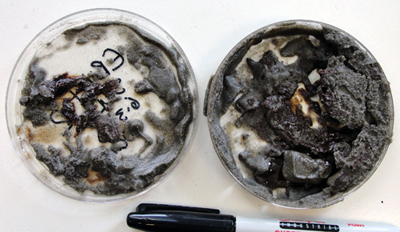 Sediment cores and water samples collected at St. George Island on June 8. These samples are not affected by oil and provide the reference data to compare with data generated in case oil affects this beach. (Photo courtesy of Markus Huettel)
Sediment cores and water samples collected at St. George Island on June 8. These samples are not affected by oil and provide the reference data to compare with data generated in case oil affects this beach. (Photo courtesy of Markus Huettel)What oceanography professors Markus Huettel and Joel E. Kostka learn will enable them to predict when most of the oil in the beaches will be gone. Their findings may also reveal ways to accelerate the oil degradation rate — and speed matters, because toxic crude components that remain buried on Gulf Coast beaches may seep into the groundwater below.
 Samples provided to professors Kostka and Huettel that consist of heavily oiled sediments from a barrier island off the coast of Louisiana. (Photo courtesy of Joel E. Kostka)
Samples provided to professors Kostka and Huettel that consist of heavily oiled sediments from a barrier island off the coast of Louisiana. (Photo courtesy of Joel E. Kostka)"This enormous oil spill affects hundreds of miles of beaches in the Gulf of Mexico," Huettel said. "We can remove the oil from the beach surface, but oil is also carried deeper into the sand, and we need to understand what happens to that oil. Preventing groundwater contamination is crucial not only to Gulf Coast residents but also to coastal management and local economies like fisheries and tourism that depend on water quality."
"We will also study the effect of the dispersant known as Corexit on oil metabolism by natural microbial communities," Kostka said. "Through contacts in the field, my laboratory has acquired Corexit and source oil from the MC252 (Deepwater Horizon) well head for use in our experiments."
St. George Island, Fla., and Dauphin Island, Ala., have served as the primary research sites since early June, when the one-year study began. In addition, the researchers have obtained heavily oiled sand from Pensacola Beach, Fla., and from a barrier island off the Louisiana coast. If warranted by the oil's movement, they will also collect near-shore water and sediment samples from other Gulf beaches.
Click here to read the whole article
